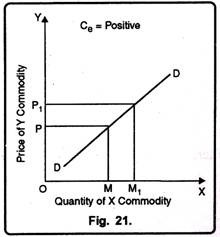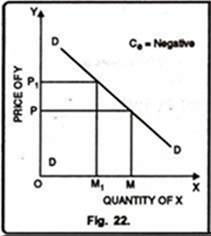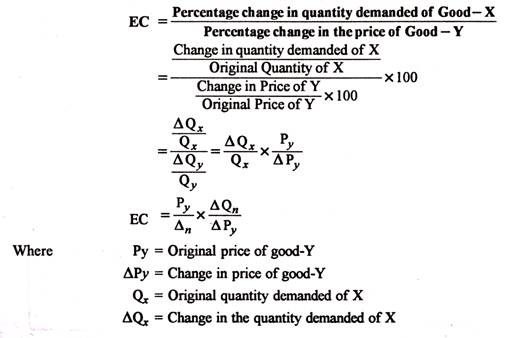Cross Elasticity of Demand: Definitions, Types and Measurement of Cross Elasticity of Demand!
It is the ratio of proportionate change in the quantity demanded of Y to a given proportionate change in the price of the related commodity X.
It is a measure of relative change in the quantity demanded of a commodity due to a change in the price of its substitute/complement. It can be expressed as:
Cross elasticity may be infinite or zero if the slightest change in the price of X causes a substantial change in the quantity demanded of Y. It is always the case with goods which have perfect substitutes for one another. Cross elasticity is zero, if a change in the price of one commodity will not affect the quantity demanded of the other. In the case of goods which are not related to each other, cross elasticity of demand is zero.
Definition:
“The cross elasticity of demand is the proportional change in the quantity of X good demanded resulting from a given relative change in the price of a related good Y” Ferguson
“The cross elasticity of demand is a measure of the responsiveness of purchases of Y to change in the price of X” Leibafsky
Types of Cross Elasticity of Demand:
1. Positive:
When goods are substitute of each other then cross elasticity of demand is positive. In other words, when an increase in the price of Y leads to an increase in the demand of X. For instance, with the increase in price of tea, demand of coffee will increase.
In fig. 21 quantity has been measured on OX-axis and price on OY-axis. At price OP of Y-commodity, demand of X-commodity is OM. Now as price of Y commodity increases to OP1 demand of X-commodity increases to OM1 Thus, cross elasticity of demand is positive.
2. Negative:
In case of complementary goods, cross elasticity of demand is negative. A proportionate increase in price of one commodity leads to a proportionate fall in the demand of another commodity because both are demanded jointly. In fig. 22 quantity has been measured on OX-axis while price has been measured on OY-axis. When the price of commodity increases from OP to OP1 quantity demanded falls from OM to OM1. Thus, cross elasticity of demand is negative.
3. Zero:
Cross elasticity of demand is zero when two goods are not related to each other. For instance, increase in price of car does not effect the demand of cloth. Thus, cross elasticity of demand is zero. It has been shown in fig. 23.
Therefore, it depends upon substitutability of goods. If substitutability is perfect, cross elasticity is infinite; if on the other hand, substitutability does not exist, cross elasticity is zero. In the case of complementary goods like jointly demanded goods cross elasticity is negative. A rise in the price of one commodity X will mean not only decrease in the quantity of X but also decrease in the quantity demanded of Y because both are demanded together.
ADVERTISEMENTS:
Measurement of Cross Elasticity of Demand:
Cross elasticity of demand can be measured by the following formula:



